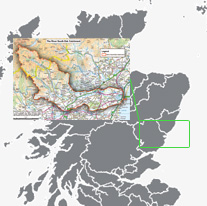Native Species
Water Vole
 Water voles are native to the UK. They were once plentiful but have been reducing in numbers drastically, especially since the 1990s. The two main reasons for this are thought to be loss of suitable bankside habitat and the spread of the American mink. Small populations are thought to exist in the upper areas but these may be lost altogether without activemanagement.
Water voles are native to the UK. They were once plentiful but have been reducing in numbers drastically, especially since the 1990s. The two main reasons for this are thought to be loss of suitable bankside habitat and the spread of the American mink. Small populations are thought to exist in the upper areas but these may be lost altogether without activemanagement.
Otter
 After a long decline in the 1960s and 1970s, otter populations appear to be thriving across Scotland. Mink, a non-native species in the area can compete with otters for food and territories, although otter surveys which were last carried out on the river South Esk in the early 1990s, showed the presence of otters along much of its length. However, despite the protection otters receive, they can still be threatened by management work such as bankside engineering or forestry operations destroying holts or resting places if an otter survey has not first been carried out.
After a long decline in the 1960s and 1970s, otter populations appear to be thriving across Scotland. Mink, a non-native species in the area can compete with otters for food and territories, although otter surveys which were last carried out on the river South Esk in the early 1990s, showed the presence of otters along much of its length. However, despite the protection otters receive, they can still be threatened by management work such as bankside engineering or forestry operations destroying holts or resting places if an otter survey has not first been carried out.
Salmon
 The South Esk and its tributaries are Special Areas of Conservation SAC for their populations of Atlantic salmon. According to Scottish Natural Heritage’s SNH) last assessment of the salmon population of the River South Esk SAC, completed in 2005, summer and autumn numbers of salmon were shown to bedoing well. However, spring fish numbers were shown to have dropped, and juvenile salmon numbers were also found to be low.
The South Esk and its tributaries are Special Areas of Conservation SAC for their populations of Atlantic salmon. According to Scottish Natural Heritage’s SNH) last assessment of the salmon population of the River South Esk SAC, completed in 2005, summer and autumn numbers of salmon were shown to bedoing well. However, spring fish numbers were shown to have dropped, and juvenile salmon numbers were also found to be low.
Overall, salmon were assessed to be in an ‘unfavourable ’condition. Water quality, in terms of nutrient enrichment, and in particular high levels of soluble reactive phosphorus, was identified by SNH as one of the possible issues affecting the salmon population. Other factors that have been raised during the consultation process include low river flows, birds and seals eating the fish, barriers preventing the fish from migrating and mixed-stock netting stations which are nets precisely placed to intercept coastal migratory salmon and sea trout from many different catchments.
Sea Trout
Sea trout are a migratory form of the brown trout. The South Esk is quite famous as a sea trout river, although sea trout numbers are also reducing, for many of the same reasons as salmon, as outlined above.
Other fish species
We do not have much information about the status of other fish species in the area. In particular, we do not know the status of brown trout even though it is an important resource in terms of fishing. The European eel is now considered to be outwith safe biological limits in terms of its population size and recent EU regulation says that member states must produce eel management plans to find measures to increase the stock of eels. The Fisheries Research Service has now produced an eel management plan for the Scotland river basin district.
Freshwater pearl mussel

The River South Esk SAC was designated for its freshwater pearl mussel populations, together with Atlantic salmon. In 2003 SNH carried out a freshwater pearl mussel survey of the River South Esk SAC and found that the population was not as healthy as it should be. It had a low population of mussels and, in particular, low numbers of young mussels (juveniles). Overall, freshwater pearl mussels were assessed as being in an 'unfavourable' condition. The survey is being repeated in2009, and we will use the results to decide how the pearl mussel population has changed since 2003 and to help us make management decisions in the future. Some of the possible reasons for the ‘unfavourable condition’ are thought to include:
- nutrient enrichment and, in particular, high levels of soluble reactive phosphorus;
- illegal pearl mussel fishing;
- river engineering in the past that has altered the hydrological and geomorphological elements and processes of the
river and may have damaged mussel habitat; and - low numbers of juvenile salmonids (trout and salmon) which act as hosts for freshwater pearl mussels when they are larva.



